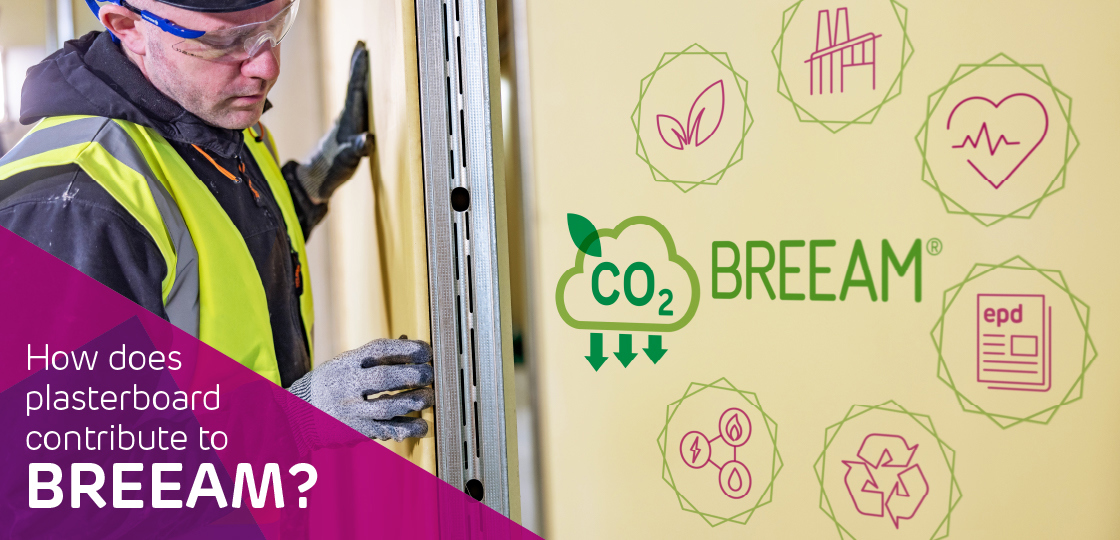
How does plasterboard contribute to BREEAM?
The construction industry has long since made a bad name for itself in all areas of sustainability. Although once synonymous with red diesel and landfill sites, an increased change of regulatory pace has demanded change from the top-down and pushed movement of sustainability initiatives. Systems have been implemented to grant better understanding of the true environmental impact of a building – with frameworks like BREEAM and LEED in-place and increasingly widely utilised. Providing a tangible measure of the impact is the aim of such tools, and a reliable, accurate method to standardise how we assess it.
Understanding BREEAM
In the UK, we measure the environmental performance of building across a single standard – BREEAM. Broadly understood as the first green building rating tool, the Building Research Establishment Environmental Method (BREEAM) weighs a building’s performance and components across several key categories, from energy usage, to waste management, through to the very materials it’s built from, to evaluate its overall performance through the lens of sustainability. The output of this assessment is a performance rating – graded on a scale ranging from ‘pass’ all the way through to ‘outstanding’.
Achieving a high rating means meeting stringent criteria. A development team looking for an Outstanding grading would need to make energy efficiencies, set a good standard of indoor environmental quality, source responsible materials, and demonstrably mitigate ecological impact.
The benefits of BREEAM
The benefits of having a (good) BREEAM rating for a building are extensive – for both those developing the building and those who will eventually use it, but they do vary. The occupants of an ‘outstanding’ BREEAM rated building could expect increased energy efficiencies, resulting in lower operating costs, and generally better health and well-being. From the perspective of a developer, a better BREEAM rating could help to enhance the marketability of a building, potentially increasing the sale value.
Choose materials carefully
The materials used in a building play a critical role in its’ overall BREEAM accreditation. Materials are individually assessed and scored for credits across each category. Each category is a channel that holds influence over the building’s BREEAM rating:
Environmental impact - the carbon footprint of a product, alongside the energy efficiency of its production processes hold the weight in this category.
Responsible sourcing – these credits are earned by choosing products from manufacturers who have committed to sourcing sustainably.
Durability – the deciding factor in this category is based largely on reliability, on the basis that high-quality materials are likely to contribute positively to a building’s longevity.
Efficiency and waste management – this category looks for efficiencies that have been made during the production and installation processes in order to minimise waste and utilise resources more efficiently.
Health and wellbeing – materials free from hazardous and harmful substances, creating a healthier indoor environment, earn credits in this area.
Where does plasterboard fit into this?
As a key material in the construction of almost any building, plasterboard has a key role to play in not just the BREEAM accreditation of a building, but in designing and creating a building in-line with sustainability best practises. In order to be eligible for BREEAM credits, a material must have an up-to-date and verified Environmental Product Declaration (EPD), but consider the following factors when choosing a plasterboard to specify. It should:
- Be manufactured using sustainable practices – look for manufacturers who are transparent about their production process
- Have low embodied carbon and environmental impact – find this on EPDs
- Be demonstrably durable – look for performance test data and classifications
- Contribute to efficient waste management – some manufacturers may even offer a waste removal service
Choosing your plasterboard
Our range of products contribute towards sustainable efforts in different ways. Across the board, Siniat products can contribute towards BREEAM credits.
Our board range have accredited Environmental Product Declarations (EPDs) for our boards, and have achieved excellent BRE Green Guide ratings, further supported by our BES6001 certification.
High sound insulation values, contributing to acoustic performance requirements, and zero-release of volatile organic compounds (VOCs), contributing to a higher standard of indoor air quality. The use of Severe Duty rated partitions in high-traffic areas may also help a building to attain credits for durable design.
Striving for a collective goal
We think that the construction industry still has a long way to go in reducing its environmental impact. Part of that journey is helping to create a common language and understanding of sustainability tools – not just for architects, but for everyone involved in the building lifecycle.
As part of our ongoing commitment, we’re delighted to provide the EPD for our Universal board, alongside many other boards in our range. To support your use of it, Siniat Head of Sustainability, Oliver Cripps, has sat down to create and record an EPD CPD session – getting to the nitty-gritty of what they are, and how to use them.
It will be available exclusively on MySiniat. If you’ve not already registered, it’s easy to sign up for a free account – join us now.
